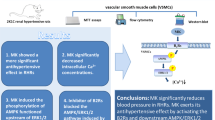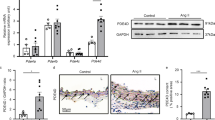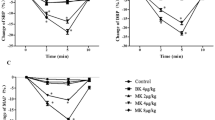Abstract
The effects of captopril (Cap) and verapamil (Ver) alone and in combination on intracellular Na+ concentration ([Na+]i) in cultured aortic smooth muscle cells(ASMC) of rabbits was evaluated by a direct measurement of [Na+]i with fluorescent dye sodium-binding benzofuran isophthalate (SBFI) combined with digital image. [Na+]i in resting cells was found to be 11.9±0.7 mmol/L. Angiotensin II (Ang-II, 0.1-10 μmol/L) induced an increase of [Na+]i in concentration-dependent manner. Ver (0.1- 10 μmol/L) inhibited Ang-II (1 μmol/L)-induced increase in [Na+]i, while Cap enhanced Ang-II-induced increase in [Na+]i at 10 μmol/L but not at 0.1-1 μmol/L. Ver(0.1-1 μmol/L)abolished enhancement of Ang-II-induced increase in [Na+]i by Cap. Thus, the inhibition of Cap-enhanced [Na+]i by Ver may provide a new hypothesis for the underlying molecular mechanism of synergistic effect of the combination of Ca2+ antagonists and angiotensin-converting enzyme inhibitors in controlling blood pressure.
Similar content being viewed by others
Introduction
Vascular smooth muscle cells possess a number of Na+ transport systems, namely Na+ channels, Na+-Ca2+, Na+-H+ exchange, and Na+-K+-2C1− co-transport1. Hypothesized roles for these systems include regulation of vascular tone, cell volume and cell proliferation. In both experimental and human hypertension aberrations in smooth muscle cell, univalent ion transport system play an important role in the pathogenesis and maintenance of hypertension2.
Angiotensin-converting enzyme (ACE) inhibitors and Ca2+ antagonists are widely used for the treatment of hypertension. The combination of both drugs produces a larger hypotensive effect than either drug given alone. However, the mechanisms of this synergistic effect is not well known. The effects of both drugs on Ca2+ fluxes mediated by agonists in vascular smooth muscle cells, which are associated with Na+ transport3 have been studied4, 5. But there is scant information as to the the effects of both drugs on Na+ regulation.
The purpose of the present study was to evaluate the effect of ACE inhibitor captopril (Cap) and Ca2+ antagonist verapamil (Ver) alone and in combination on angiotensin (Ang-II)-induced changes in intracellular Na+([Na+]i) in aortic smooth muscle cells (ASMC).
Materials and Methods
Sodium-binding benzofuran isophthalate (SBFI)/acetoxymethyl ester(AM) and SBFI was from Sigma. Ang-II was from Sigma. Cap was obtained from Chang Zhou Pharmaceutical Factory, Ver from Shanghai Tian-Ping Pharmaceutical Factory. Mouse anti-human actin and sheep anti-mouse IgG/FITC were purchased from Sino-American Biotechnolgy Co. Medium-199 was from Nissui. Pluronic F-127 and Me2SO were purchased from Sigma.
Cell culture
Passages 9-11 ASMC derived from thoracic aortae of rabbits were cultured as described previously4. Immunocytochemical characterization of ASMC was performed using monoclonal antibodies mouse anti-human actin against smooth muscle-specific α-actin6. Cultured ASMC showed positive staining for α-actin with a fluorescence marker sheep anti-mouse IgG/FITC. For the experiments, the cells were grown on thin glass coverslips at a density of (1-5) ×105/ml. 2 d later, the medium was aspirated and the cells were made quiescent by incubation in Medium-199 containing 0.1% bovine serum albumin and indicated concentration of Cap and Ver for 48 h before the studies.[Na+]i change was assessed 6-7 h after the exposure to Ang-II.
Fluorescent dye loading
Cell-grown cover slips were rinsed twice with HEPES-buffered solution (HBS) (mmol/L: NaCl 1, KCl 5.4 CaCl2 1.2, MgCl2 1.2, HEPES 10, glucose 5) and loaded for 2 h at 37 °C in same HBS containing 5μmol/L SBFI/AM dispersed with 0.2 % Pluronic F-127, a nonionic surfactant. After loading, the cells on cover slips were superfused for 10 min twice with HBS, and then transferred to a tissue chamber mounted on a microscope stage.
Digital imaging methods and image analysis
SBFI fluorescence (500 nm emission excited by 340 nm illumination) from the cells was imaged using a Nikon UV-Fluor objective. The fluoresent images were recorded by photograph (Fig 1). By means of digital image methods as well as PC Vison Plus Frame Grabber (Imaging Technology Inc.,USA), Panasonic color CCTV camera (Matsushita Communication Industrial, Japan) and software (supported by Department of Computer to Medicine, Shanghai Second Medical University), the grey values of image of SBFI-loaded cells were obtained and converted to [Na+]i on calibration curve.
Calibration of [Na+]i
SBFI was calibrated within the cell (in situ calibration) by superfusion of the SBFI-loaded cells with solution containing various Na+ concentrations1. In the present work, calibration of the excitation in terms of [Na+]i was accomplished in vitro by the application of SBFI with solutions in which the Na+ concentration varied from 0 to 20 mmol/L (Fig 2). Na+ calibration solutions were made from appropriate mixtures of Na+ and K+ solutions (Na+ + K+ = 135, CaCl2 1.2, MgCl2 1.2, Hepes 10, glucose 5 mmol/L).
Statistics
Data are represented as x ± s of 40 cells of 4 rabbits, 10 cells/rabbit (as one group). Unpaired t-test was used to test the significance of the data. When the differences between group means were evaluated by analysis of multiple variance, it was found to be statistically not significant.
Results
Ang-II-induced changes in [Na+]i
[Na+]i level in resting cells (growth arrest for 48 h in Medium-199 containing 0.1% bovine serum albumin at 37 °C) was 11.9 ± 0.7 mmol/L. When resting cells were exposed to Ang-II for 7 h, a concentration-dependent increase in [Na+]i was seen. [Na+]i produced by Ang-II at 0.1, 1, 10 μmol/L was 12.1 ± 0.4, 12.3 ± 0.6, and 12.4 ±0.5 mmol/L, respectively. The maximal amplitude of the increase in [Na+]i was 0.5 mmol/L.
Effect of Vet and Cap on Ang-II-induced changes in [Na+]i
The experimental protocol (growth arrest for 48 h in Medium-199 containing 0.1% bovine serum albumin supplemented with the indicated concentration of Ver or Cap at 37 °C) was used to determine whether Ver or Cap could alter Ang-II-induced increase in [Na+]i. Ver at 0.1, 1, 10 μmol/L significantly inhibited Ang-II-induced increase in [Na+]i (Tab 1). Cap had little effect on response to Ang-II at 0.1 and 1 μmol/L, but enhanced Ang-II-induced increase of [Na+]i at 10 μmol/L (Tab 1). However, in the presence of Ver at 0.1 or 1 μmol/L, the enhancement of Ang-II-induced increase in [Na+]i by Cap was abolished (Fig 3).
The effect of verapamil (Ver) on the enhancement of angiotensin II (Ang-II, 1 μmol/L)-induced increase in [Na+]i by captopril (Cap, 10 μmol/L) in rabbit aor-tic smooth muscle cells. x±s, n = 40 cells of 4 rabbits, 10 cells/rabbit. **P<0.05, ***P<0.01 vs control. A: Cap + Ang-II. B: Ver (0.1μmol/L) + Cap + Ang-II. C: Ver (1μmol/L) + Cap + Ang-II.
Discussion
In the present study, [Na+]i was measured with SBFI, monitored by digital imaging fluorescent microscope at a single-cell level and estimated with in vitro calibration protocol. The mean basal [Na+]i determined in ASMC was 11.9 mmol/L. This value is closed to 13 mmol/L reported by Okada et al3 which was measured in cuvette for SBFI-loaded rat aorta smooth muscle cells. When the resting cells were exposed to Ang-II for 7 h, a concentration-dependent increase in [Na+]i was seen. In the presence of Ver (0.1 to 10 μmol/L), this increase in [Na+]i was prevented. Clinical data showed that oral application of Ver and ditiazem caused a decrease in [Na+]i in the leukocyte and erythrocyte of hypertensive patients7, 8. Our results support the clinical observation, thereby suggesting that a blockade of Ca2+ channel, second to the inhibition of Ca2+-dependent rise in [Na+]i 1, may play a part in hypotensive effect of Ca2+ antagonists.
We also found that Cap enhanced Ang-II-induced increase in [Na+]i at 10 μmol/L but not at 0.1-1 μmol/L. Accetto et al9 demonstrated that Cap produced inhibition of K+-induced relaxation of rat tail artery. In the study of Unger et al10, a significant initial pressor effect was observed when Cap was delivered into the lateral cerebral ventricles of stroke-prone spontaneously hypertensive or Wistar-Kyoto control rats. Therefore, these findings suggested that an increase in [Na+]i produced by Cap could contribute toward the increased arterial tone and blood pressure.
Is the enhanced effect of Cap on Ang-II-induced increase in [Na+]i relevant to the clinical use of the drug? Cap peak plasma levels of 0.8 to 1.8 μg/ml were measured after oral administration of approximately 5 to 10 μmol/L Cap11. Cap concentration required for the enhancement of Ang-II-induced increase of [Na+]i in the present work (10 μmol/L) was still in the therapeutic range. Thus, an increase in [Na+]i may lead to the limitation of hypotensive effect of the drug. As Cap concentration (IC50) required to block angiotensin I conversion was 0.02 μmol/L9, while Cap 0.1 and 1 μmol/L in the present work did not affect Ang-II-induced increase in [Na+]i, low dose of Cap may be reasonable for the clinical use. Interestingly, in the presence of Ver, the enhanced Ang II-induced increase of [Na+]i by Cap was abolished. Perhaps, this can explain partially the clinical findings of a synergistic effect of the combination of Ca2+ antagonists and ACE inhibitors in controlling blood pressure.
In summary, this study demonstrated that Ver inhibited and Cap (10 μmol/L, but not 0.1 or 1 μmol/L) enhanced Ang-II-induced increase in [Na+]i and that the combination of both drugs could abolish increase in [Na+]i induced by Cap. Therefore, these results may provide a new hypothesis for the underlying molecular mechanism of synergistic effect of the combination of Ca2+ antagonists and angiotensin-converting enzyme inhibitors in controlling blood pressure.
References
Borin ML, Goldman WF, Blaustein MP . Intracellular free Na+ in resting and activated A7r5 vascular smooth muscle cells. Am J Physiol 1993; 33:C1513–24.
Orlov SN, Resink TJ, Bernhardt J, Buhler FR . Na+-K+ pump and Na+-K+ co-transport in cultured vascular smooth muscle cells from spontaneously hypertensive and normotensive rats: baselin activity and regulation. J Hypertens 1992; 10:733–40.
Okada K, Ishikawa S, Saito T . Enhancement of intracellular sodium by vasopressin in spontaneously hypertensive rats. Hypertension 1993; 22:300–5.
Qi JH, Zhang L, Wang J, Wei PJ, Gu PK, Jin ZJ et al. Effects of captopril and enalapril on intracellular Ca2+ in vascular smooth muscle cells. Acta Pharmacol Sin 1995; 17:142–45 (in Chinese).
Zhu Z, Tepel M, Neusser M, Mehring N, Zidek W . Effect of captopril on vasoconstriction and Ca2+ fluxes in aortic smooth muscle. Hypertension 1993; 22:806–11.
Bendhack LM, Sharma RV, Bhalla RC . Altered signal transduction in vascular smooth muscle-cells of spontaneously hypertensive rats. Hypertension 1992; 19(Suppl II):II-42–II-48.
Poston L, Gray HH, Crowther A et al. Cellular sodium concentration and vasoconstrictor state in hypertension. J Cardiovasc Pharmacol 1984; 6:s16–s20.
Khalil-Manesh F, Venkataraman K, Samant DR, Gadgil UG . Effects of ditiazem on cationtransport across erythrocyte membranes of hypertensive humans. Hypertension 1987; 9:18–23.
Accetto R, Rinaldi G, Weder AB . Captopril inhibitor ouabain -sensitive Na+/K+-ATPase. Clin Physiol Biochem 1989; 7:101–8.
Unger T, Kaufmann-Buhler I, Scholkens B, Ganten D . Brain converting enzyme inhibition: a possible mechanism for the antihypertensive rats. Eur J Pharmacol 1981; 70:467–78.
Duchin KL, Singhvi SM, Willard DA . Captopril kinetics. Clin Pharmacol Ther 1982; 31:452–9.
Author information
Authors and Affiliations
Additional information
Project in part supported by the National Natural Science Foundation of China, No. 39270779
Rights and permissions
About this article
Cite this article
Qi, J., Zhang, L., Wang, J. et al. Effect of captopril or verapamil on intracellular sodium in cultured vascular smooth muscle cells. Cell Res 6, 47–53 (1996). https://doi.org/10.1038/cr.1996.6
Received:
Revised:
Accepted:
Issue Date:
DOI: https://doi.org/10.1038/cr.1996.6






